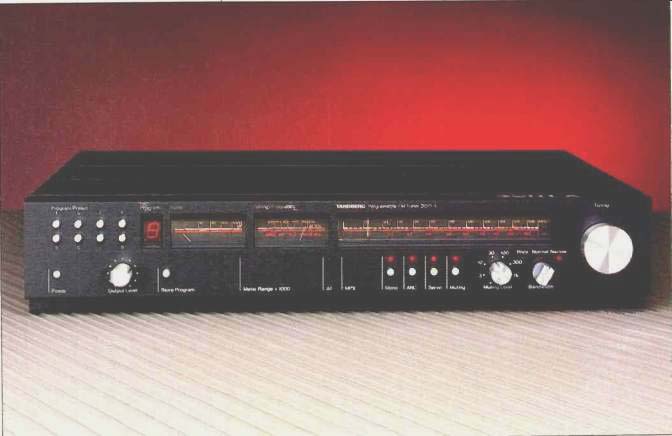
Manufacturer's Specifications:
Mono Usable Sensitivity: Wide, 7.5 dBf, normal, 6.8 dBf; narrow, 8.2 dBf.
50-dB Quieting: Mono, wide, 11.25 dBf; normal, 10.3 dBf; narrow, 9.3 dBf.
Stereo, wide, normal, and narrow, 32.1 dBf.
S/N: Mono, 95 dB; stereo, 82 dB; stereo at 85 dBf, 92 dB.
Muting Threshold: Variable, 11.2 to 81 dBf.
Stereo Threshold: 25 2 dBf.
Frequency Response: Mono or stereo, 30 Hz to 15 kHz, +0.2,-0.5 dB.
Mono THD: Wide, 0.03% at 100 Hz, 1 kHz, and 6 kHz; normal, 0.06% at 100 Hz and 1 kHz, 0.055% at 6 kHz; narrow, 0.12% at 100 Hz, 0.25% at 1 kHz, 0.45% at 6 kHz.
Stereo THD: Wide, 0.04% at 100 Hz and 1 kHz, 0.1% at 6 kHz; normal, 0.05% at 100 Hz and 1 kHz, 0.25% at 6 kHz; narrow, 0.08% at 100 Hz, 0.2% at 1 kHz, 1.0% at 6 kHz.
IM Distortion: Mono or stereo, wide, 0.1%, normal, 0.15%, narrow, 0.8%.
Capture Ratio: Wide, 0.4 dB; normal, 1.0 dB; narrow, 3 dB.
Adjacent-Channel Selectivity: Wide, 3 dB; normal, 12 dB; narrow, 40 dB.
Alternate-Channel Selectivity: Wide, 30 dB; normal, 90 dB: narrow, 90 dB.
Spurious-Response Rejection: 135 dB.
Image Rejection: 135 dB.
I.f. Rejection: 135 dB.
AM Rejection: Greater than 70 dB.
Separation: Wide, 60 dB at 100 Hz and 1 kHz, 50 dB at 10 kHz; normal, 60 dB at 100 Hz and 1 kHz, 45 dB at 10 kHz; narrow, 55 dB at 100 Hz and 1 kHz, 35 dB at 10 kHz.
19-kHz Suppression: 95 dB.
38-kHz Suppression: 120 dB.
Signal Meter Range: 0.3 µV to 1 mV or 1 mV to 3 V.
Power Requirements: 115 V ( ± 10%), 50/60 Hz, 34 watts.
Dimensions: 17 1/8 in. W x 3 1/4 in. H x 13 3/4 in. D (43.5 cm x 8.3 cm x 35 cm).
Weight: 15.3 lbs. (7 kg).
Price: $1,995.
Company Address: 122 Dupont St., Plainview, N.Y. 11803.
-- - -- - - -

I've had the Tandberg 3001 A FM tuner sitting in my lab for nearly six months now. I've been reluctant to write this report any sooner, since that would have meant giving up this fantastic tuner and returning it to Tandberg. Those of you who have been reading my reports for some time know that I am an FM-tuner addict. Show me an outstanding unit such as the 3001 A, and it's love at first sight. I just can' bear to part with it! About the only negative thing I have to say about the Tandberg is that it gave me some worry about whether my test equipment would be good enough to accurately measure its performance.
As for the high price, that, unfortunately, goes with the territory. If you want a tuner that offers distortion lower than what you'd get from some of the best amplifiers around plus sufficient dynamic range to handle some of today's better FM program sources (such as CDs and live, uncompressed broadcasts), I know of no other model at any price that will do the job as well as the 3001 A. Of course, at this point I should back up a bit and tell you that if all you listen to are the typical, compressed rock 'n' roll stations that clutter the FM dial in most locations, don't waste your money on this unit. But if, like me, you listen to the one or two stations in your area that take special pride in putting out the very best FM signal possible, then the Tandberg 3001 A may be just what you've been looking for-and you'll want it no matter what it costs.
The Tandberg 3001 A is an analog tuner. By this I mean that it does not employ frequency-synthesized tuning. The analog approach was selected by Tandberg's talented engineers not so much because they could use a familiar (and perhaps easier-to-read) dial scale and dial pointer, but rather so that they could achieve the highest possible signal-to-noise ratios-in excess of 90 dB in mono and well over 80 dB in stereo.
The front-end employs eight ganged, tuned circuits to obtain startlingly high selectivity when needed. The tuning elements are voltage-controlled capacitance diodes, and dual-gate MOS-FETs are used in the r.f. and mixer stages.
In addition to the main tuning system, there is a tuning circuit that permits eight preset FM station frequencies to be stored in memory. This particular circuit is based on a voltage-synthesis principle combined with a fast analog servo loop that achieves maximum signal-to-noise ratio and frequency stability.
The i.f. filter circuits can be switched to three different bandwidths (wide, normal, and narrow). These filters consist of phase-linear block filters, plus pure LC filters, to achieve high selectivity with extremely low distortion. The special limiter circuit used in this design provides exceptionally good AM and spurious-response rejection. In addition, it ensures a constant signal output over a very wide range of input signal levels.
These days, most MPX (stereo) decoders in FM tuners and receivers consist of a single IC surrounded by a few components for 19- and 38-kHz tuned circuits. Although IC technology has certainly gotten better over the last decade, this type of design still has some inherent limitations. The Tandberg employs a decoder designed entirely with discrete components. As a result, there are none of the "beat" notes-either within the audio pass-band or outside of it- found when measuring and listening to most stereo FM tuners. Another feature of the decoder design is Tandberg's Automatic Noise Cancelling (ANC) circuit. Like the similar circuits more common in car stereos (but also found in a few home components), it offers a significant improvement in signal-to-noise ratio by reducing stereo separation as signal strength decreases. Finally, a seventh-order multiplex filter ensures accurate phase response right out to the 15-kHz limit of FM broadcasting.
The signal meter of the 3001 A operates over two ranges so that you can accurately read incoming signal levels from as low as 3µV to as high as 3 V! An LED indicator below the meter tells you when to switch meter ranges. A second meter serves two purposes. Primarily, it acts as a precise center-of-channel tuning meter. When a preset station has been selected, however, this meter becomes a frequency indicator. The display area normally shows the number of the chosen preset, but it also shows when the storage function has been selected.
Three different muting circuits provide noise-free tuning, and the muting threshold is adjustable from about 1 to 3 mV. Although the tuning system is augmented by a servo type of automatic frequency control or frequency lock, this circuit is automatically deactivated whenever you touch the tuning knob. In addition to the fixed-level output on the rear panel, the 3001 A is also equipped with variable outputs hat can deliver signal levels of up to 2.5 V rms with a 100%-modulated signal. This high output level nicely matches the typical output of CD players, so you don't have to keep adjusting your volume control every time you switch from FM to CD or vice versa.
Control Layout
Eight small station-preset buttons are at the left end of the panel. Beneath them are the power switch and the level control for the variable outputs. Moving to the right, there is he display area, a button for storing presets, the dual-range signal-strength meter, the center-tune/preset-frequency meter, and the calibrated frequency scale used during manual tuning. Four tiny buttons beneath the dial scale, augmented by indicator lights, select mono or stereo and activate the ANC circuit, the servo (AFC), and the muting circuitry. A rotary knob nearby sets muting threshold, and a three-position rotary switch chooses i.f. bandwidth (wide, normal, or narrow). A large tuning knob, coupled to a flywheel, completes the front-panel layout.
The coaxial antenna connector on the rear panel is neither a standard F-type connector nor a BNC type. Fortunately, Tandberg provides a male plug to which the inner and outer conductors of a coaxial (75-ohm) antenna transmission line can be easily attached. No soldering is required. Because his tuner is sold internationally, the rear panel has a de-emphasis switch with settings for 25, 50, or 75 µS. (De-emphasis of 50 µS is used in European countries, and the 25-µS setting is for use with stations that employ Dolby FM.) In addition to the variable and fixed pairs of output jacks, a detector output jack on the rear panel delivers the signal that's available prior to multiplex circuit decoding. You might want to extract the signal at this point if you want to use Dolby decoding. Finally, two jacks can be connected to he horizontal and vertical inputs of an oscilloscope so that you can use the 'scope as a guide to minimize multipath when orienting your antenna.
Measurements
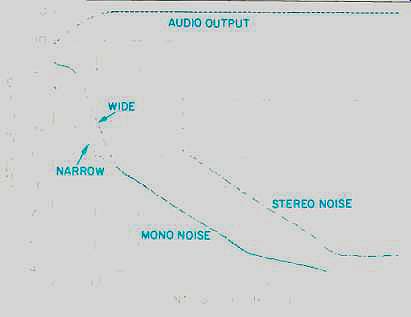
Fig. 1-Mono and stereo quieting characteristics.

Fig. 2-THD + N vs. signal strength at 1 kHz.
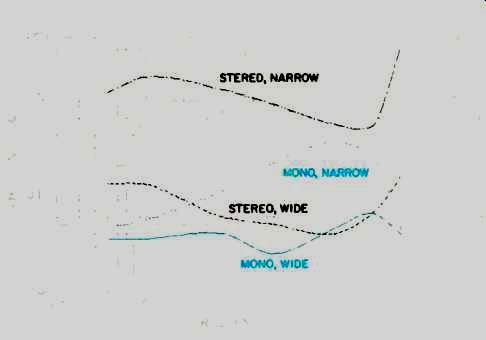
Fig. 3-THD + N vs. frequency.
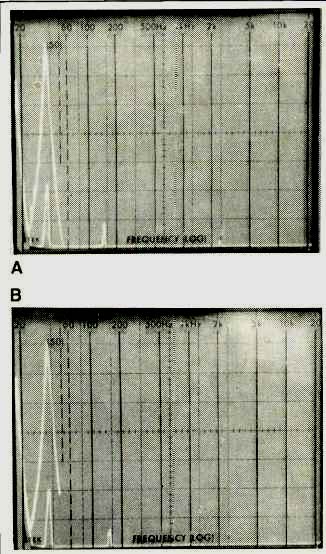
Fig. 4-Separation and crosstalk components for a 5-kHz FM modulating signal
in wide (A) and narrow (B) i.f. modes. Note the negligible third-harmonic
component and the total absence of beats.
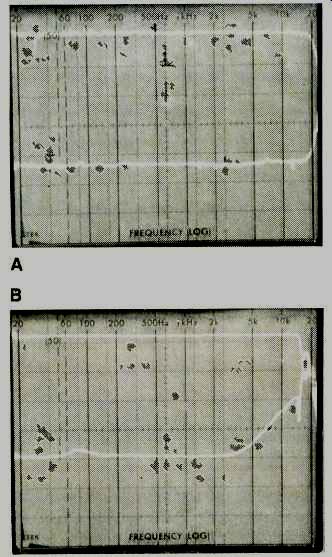
Fig. 5--Frequency response (top trace) and separation vs. frequency (bottom
trace) in wide (A) and narrow (B) i.f. modes.
Figure 1 shows how background noise varies with input signal strength. Mono usable sensitivity in the wide i.f. mode measured an amazingly low 8.5 dBf! Even in the narrow mode, mono usable sensitivity was still as good as the figures I've obtained for most conventional frequency-synthesized tuners: Around 11.5 dBf. Stereo usable sensitivity was governed by the stereo threshold, which was set at approximately 22 dBf. In mono, 50-dB quieting required a signal input of only 12.9 dBf, regardless of bandwidth set ting; in stereo, 50-dB quieting was reached with a signal input level of 32 dBf. Above 20 dBf, there was virtually no difference in the mono quieting characteristics, regardless of the bandwidth setting. Below this level, however, initial quieting was a bit steeper when the i.f. bandwidth was set to the narrow mode. This difference is plotted in Fig. 1 as well.
Maximum signal-to-noise ratio in mono measured 88 dB at 65 dBf and rose to about 90 dB at higher input signal levels. I suspect that my generator is incapable of reading above 90 dB, so Tandberg's claim of 95 dB for mono S/N may well be true. In any case, these are the highest S/N readings I've ever obtained for any tuner, bar none! In stereo, S/N reached 84 dB, 2 dB higher than claimed.
Because distortion tends to rise (especially in stereo) as bandwidth is reduced, it was necessary to make three separate plots of mono THD + N versus signal strength and three more plots for stereo operation (Fig. 2). In wide-mode mono, THD + N was an incredibly low 0.025% for a 1-kHz test signal at 100% modulation and an input signal strength of 65 dBf. In wide-mode stereo, THD + N was still amazingly low-only 0.05% for a 65-dBf input signal. With stronger wide-band signals, THD + N was even lower. For example, at 80 dBf of input signal, the stereo reading was only 0.035%.
As was to be expected, normal and narrow i.f. modes yielded higher THD + N figures in both mono and stereo operation. However, even the worst-case figures for mono and stereo (0.21% and 0.7%, respectively) were still low enough so as not to seriously impair reproduction of music during subsequent listening tests.
Figure 3 shows how THD + N varies with modulating frequency. Here, only four sets of measurements were taken-two for mono and two for stereo-since, in the normal-bandwidth mode, performance fell in between the extremes shown in the curves. In the narrow mode, THD + N for a 10-kHz modulating signal, measured without a low-pass filter in the signal path, was 0.045% in mono and 3.0% in stereo. In the wide i.f. mode, which produced the lowest distortion for the 10-kHz modulating frequency, measurements were 0.04% for mono and 0.15% for stereo.
Perhaps the most remarkable performance characteristic of the 3001 A became obvious when I made my usual spectrum analysis to see what was present at the two outputs when a 5-kHz signal was used to modulate one channel. Figures 4A and 4B seem, upon first observation, to be identical. Upon closer examination, you may notice that the level of the third-harmonic distortion component is slightly higher with the tuner in wide mode (Fig. 4A) than when it is in narrow mode (Fig. 4B). Yet no "beats" or other spurious components are seen in the region from 0 Hz to 50 kHz in this linear-sweep spectrum analysis. Clearly, the discrete-component MPX decoder circuit used by Tandberg has paid off! When I measured stereo separation, about the only difference I could detect between wide and narrow operation was a very slight reduction at the high-frequency end of the spectrum, as shown in Figs. 5A and 5B. In the wide mode, separation measured 57 dB at mid-frequencies, decreasing slightly to 55 dB at 100 Hz and to 50 dB at 10 kHz. Even with the i.f. bandwidth set to narrow mode, was still greater than 45 dB at mid-frequencies and nearly 30 dB at 10 kHz.
The lowest figure for capture ratio that I was able to measure was 0.8 dB, higher than claimed by the manufacturer but still about the best I've ever seen for a tuner.
Image, i.f., and spurious-response rejection all read 100 dB on my test instruments, but I hasten to add that this is the highest I am able to read, given the signal-strength ranges of my two FM signal generators.
Adjacent-channel selectivity is something I generally don't measure (the procedure is tricky and requires great care in tuning), but in light of the figures quoted by Tandberg, I couldn't resist. After several tries, I came up with a reading of 38 dB for the narrow mode (that's when it's really important) and 10 dB for the normal mode-close enough to Tandberg's claimed figures. Alternate-channel selectivity is a lot easier to measure accurately, and my figures agreed almost exactly with those claimed-except that I measured 5 dB more alternate-channel selectivity in narrow mode than Tandberg's spec of 90 dB.
Even when I turned up the gain on my oscilloscope and looked at the amplified distortion output on my analyzer, I was unable to detect the slightest trace of 19- or 38-kHz components at this tuner's output when it was fed with a stereo pilot signal. This suggests that Tandberg's claimed 95 dB of 19-kHz rejection and 120 dB of 38-kHz suppression may well be correct. In any case, I'm willing to take their word for it, though again, there's no way I could confirm these numbers using my best FM generator as a signal source.
Use and Listening Tests
I must confess: I think there's something wonderful about a dial scale and a rotary tuning knob. Although I deal with digital displays of all kinds on a daily basis (from my wrist watch to my computer screen and my scientific calculator), I still enjoy watching a dial pointer glide smoothly across a calibrated scale. The whole arrangement sort of lets me know were I am. As the Tandberg dial pointer approaches a desired frequency and the tuning meter makes its way towards its center or perfect-tuned indication, I somehow derive a sense of satisfaction from it all.
As I indicated earlier, I've had more than the usual amount of time to listen to this unit: it's been set up as my reference tuner for several months now. In my listening area (a suburb of New York City), I was able to use the wide i.f. mode for only about six of the 50-odd stations that I am able to receive. About 40 more were handled nicely with the 3001 A set to "Normal," and another four or five, which had been all but unusable with many other tuners because of adjacent-channel interference, really benefited from the "Narrow" setting.
If you should end up buying this tuner and you own any kind of oscilloscope, I strongly recommend that you take the trouble to connect the 'scope to the 3001 A's multipath jacks. I would hope that, having spent the kind of money this tuner costs, you'd go all the way and install an outdoor antenna. But even with an indoor antenna, you'll find that orienting it with the aid of the multipath display on the 'scope will result in audible improvement. Moderate multipath distortion isn't always easy to identify as such by ear. Watching an oscilloscope while you rotate the antenna for the least possible multipath is really the best way to minimize this form of distortion.
I wish that more stations in my area were good enough to justify the purchase of a tuner such as this one. Unfortunately, there are only two or three. But listening to those few using the Tandberg 3001 A really shows what FM can do and what it was meant to do.
One last point: If you should become as enamored of this tuner as I have, don't be discouraged by the length of its owner's manual. Though 35 pages long, it's written in no fewer than six languages, so you can thumb past the translations in Swedish, Dutch, Norwegian, French, and German to find the English paragraphs. The back page is filled with specifications, and I must say that Tandberg is one of the few companies that bother to list every last bit of technical data prescribed by the IEEE/IHF Standard for Tuner Measurement. Why shouldn't they? After all, every one of those listed specifications is about as good as it can get, given the present state of the FM art. Even more important, nearly all of those specs are actually met or exceeded. It's always been my practice to hold on to equipment until my report actually appears in print. Maybe I can get Audio to drag its heels a little and let me keep this tuner for another couple of months after all.
--Leonard Feldman
(Source: Audio magazine, Mar. 1988)
Also see:
Tandberg TCA 3018A Preamp and TPA 3026A Amp (Apr. 1987)
Sony ST-J75 FM Tuner (Apr. 1981)
= = = =